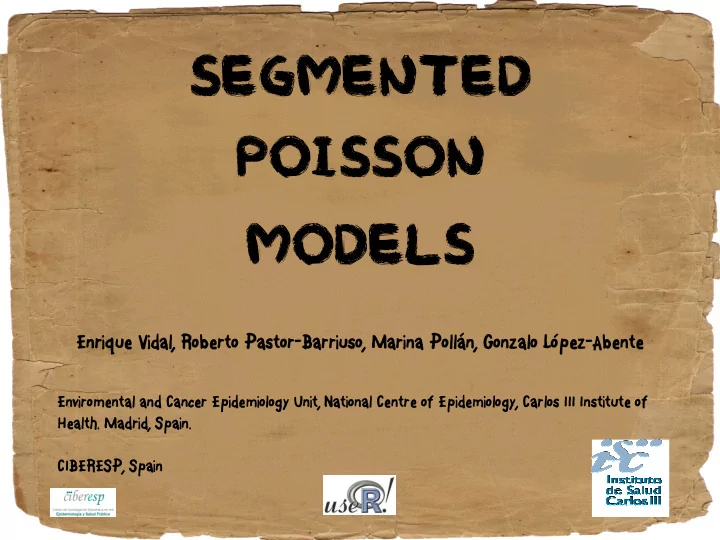

Segmented Poisson models Enrique Vidal, Roberto Pastor-Barriuso, Enrique Vidal, Roberto Pastor-Barriuso, Marina Pollán, Gonzalo López-Abente Marina Pollán, Gonzalo López-Abente Enviromental and Cancer Epidemiology Unit, National Centre of Epidemiology, Carlos III Institute of Health. Madrid, Spain. CIBERESP, Spain
background There are many situations in which threshold effects could be supposed to explain dose-response relationship 30 @ Diabetes Response 20 @ Mortality trends 10 0 @ Physics 0 2 4 6 8 10 Dose We need tools to deal with dose-response analyses
background Standard dose-response analyses provide flexible tools to describe the overall Standard dose-response shape of the relationship 30 * Categorical Analyses Response 20 * Non Parametrical Regressions 10 0 * Splines 0 2 4 6 8 10 Dose BUT identification of change points is subjective We need to test existence & location of possible change points
background Standard dose-response analyses provide flexible tools to describe the overall Standard dose-response shape of the relationship 30 * Categorical Analyses 20 Response * Non Parametrical Regressions 10 * Splines 0 0 2 4 6 8 10 Dose BUT identification of change points is subjective We need to test existence & location of possible change points
background One choice could be linear joinpoint regression 30 + It tests existence of joinpoints Response 20 + It’s already implemented 10 0 - It assumes an abrupt transition 0 2 4 6 8 10 Dose May be smooth transitions will be more plausible in many biological settings
Aim It would be desirable to find a model that assess changes in response trends related to a dose variable tests existence and location of change points allows a gradual transition at the change point could be implemented in R code
model We propose a Segmented Poisson Model with Poisson variance for aggregated counts Free dispersion parameter for extra variance (small areas) 2 intersecting straight lines for differential dose-response Hyperbolic transition function for smoothness at the change point Hyperbolic Transition and a log link function γ = σ γ = 0,5 σ λ ) λ β 2 )( c - = α Ζ + β + γ = 0,1 σ log[ E ( d )/ n ] β i i 0 β 1 + β Response + β − λ + β − λ 2 + γ 2 ( c ) ( c ) β 0 + ( β 1 2 β 0 + ( β 1 - β 2 )( c - λ ) λ - σ λ λ + σ
Estimation For change point and transition parameter fixed, the function is lineal in ß so existence is tested performing a grid search over the dose variable, and applying improved Bonferroni corrections for multiple search to a likelihood ratio test location is estimated by searching around de ML knot of the above grid. Its CI is approximated by cubic spline interpolation over the knots Once the existence and location of the change point has been assed, the final model is fitted to obtain the corresponding slopes
function Input Data, as data frame Outcome variable, as character Dose variable, as character Covariates (offset), as formula Output Change Point existence test Change point location point & interval estimates Slopes below & above change point
examples [1] Renal cancer mortality Response: Deaths by municipalities in Spain (1994-2003) Dose: Distance to he nearest metallurgical facilities (EPER) Covariables: Expected cases (offset), age, sex, socio-eco. ind. [2] Breast cancer incidence: Response: New cases from 16 (of the 50) Spanish registers Dose: Year of diagnosis (1970-2004) Covariables: Person-years (offset), register
Results [1] Renal cancer mortality It does exist a change point (p-value < 0.005), located at 17 Km (CI 95% 0 28 Km) away from the point source * Renal Cancer Mortality 0 25 50 Km 2.0 1.5 Relative Risk 1.0 Significant decrease of renal cancer mortality with further distance bellow change point, no trend above it 0.5 0 20 40 60 80 100 Distance / Km
Results [2] Breast cancer incidence B reast C ancer Incidence 2 Rate ratio 1 0.5 1970 1975 1980 1985 1990 1995 2000 2005 Year It does exist a change point (p-value < 10 -10 ), happening in year 1999 (CI 95% 1996 2001) Breast cancer incidence increased in Spain (2.8% per year) during the 70s, 80s &90s and levelled in the XXI century
Thank you
Recommend
More recommend